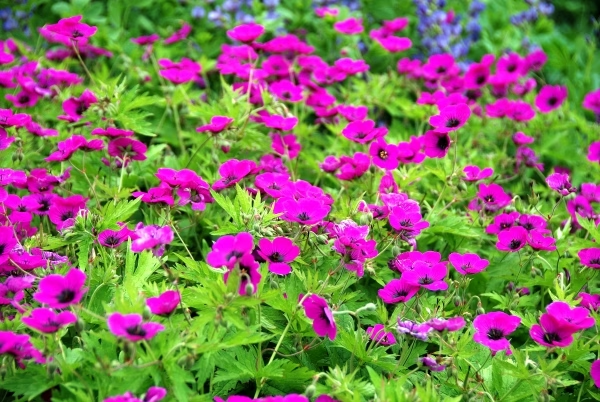
Cranesbill
Botanical Name
:
Geranium spp.
Plant Type
:
Herbaceous perennial
Seasons
:
Plant in spring or fall; blooms from late spring to early fall
Sun Level
:
Full sun to partial shade; prefers at least 4–6 hours of sunlight daily
Ideal Soil Temperature for Planting
:
55°F–75°F (13–24°C)
Soil Type
:
Well-drained loam, clay, or sandy soil; tolerates a variety of soil conditions
Hardiness Zones
:
3–9 (USDA)
Germination
:
14–30 days
P.H. Level
:
Neutral to slightly acidic (6.0 to 7.0)
Water/Irrigation
:
Moderate water needs; drought-tolerant once established
Fertilization
:
Light feeding in spring with a balanced fertilizer; excessive nutrients may reduce blooms
Habit
:
Mounded, spreading habit
Propagation
:
Self-seeding and division
Final Plant Height
:
1–2 ft
Spread
:
1.5–3 ft
Flowers
:
Small, cup-shaped blooms in shades of pink, purple, blue, and white; five-petaled with dark veining
Attracts
:
Bees, butterflies, and other pollinators
Uses
:
Ground cover, borders, rock gardens, and cottage gardens
Companions
:
Salvia, Coreopsis, Echinacea, and Nepeta
Pruning
:
Trim back after the first bloom to encourage reblooming; cut down in late fall or early spring for fresh growth
Toxicity
:
Non-toxic to humans and pets
Pests
:
Generally pest-resistant but may attract aphids or slugs
Diseases
:
Susceptible to powdery mildew and rust in humid conditions
Fun Fact
:
The name “cranesbill” comes from the seed capsule’s resemblance to a crane’s bill
Botanical Name
:
Geranium spp.
Plant Type
:
Herbaceous perennial
Seasons
:
Plant in spring or fall; blooms from late spring to early fall
Sun Level
:
Full sun to partial shade; prefers at least 4–6 hours of sunlight daily
Ideal Soil Temperature for Planting
:
55°F–75°F (13–24°C)
Soil Type
:
Well-drained loam, clay, or sandy soil; tolerates a variety of soil conditions
Hardiness Zones
:
3–9 (USDA)
Germination
:
14–30 days
P.H. Level
:
Neutral to slightly acidic (6.0 to 7.0)
Water/Irrigation
:
Moderate water needs; drought-tolerant once established
Fertilization
:
Light feeding in spring with a balanced fertilizer; excessive nutrients may reduce blooms
Habit
:
Mounded, spreading habit
Propagation
:
Self-seeding and division
Final Plant Height
:
1–2 ft
Spread
:
1.5–3 ft
Flowers
:
Small, cup-shaped blooms in shades of pink, purple, blue, and white; five-petaled with dark veining
Attracts
:
Bees, butterflies, and other pollinators
Uses
:
Ground cover, borders, rock gardens, and cottage gardens
Companions
:
Salvia, Coreopsis, Echinacea, and Nepeta
Pruning
:
Trim back after the first bloom to encourage reblooming; cut down in late fall or early spring for fresh growth
Toxicity
:
Non-toxic to humans and pets
Pests
:
Generally pest-resistant but may attract aphids or slugs
Diseases
:
Susceptible to powdery mildew and rust in humid conditions
Fun Fact
:
The name “cranesbill” comes from the seed capsule’s resemblance to a crane’s bill
Written by Nondiah Khalayi – https://www.linkedin.com/in/nondiah-khalayi/

